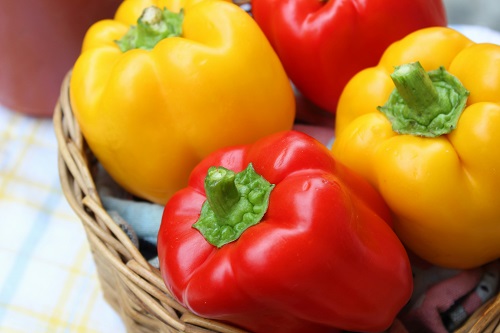Capsicum Farming Business

- Type: Agriculture/Farming
- Key Products for Sale:
Fresh capsicum (bell peppers) in various colors (green, red, yellow)
Capsicum seedlings
Value-added products (e.g., capsicum sauce, pickles) - Technology Considerations:
Drip irrigation systems for efficient water management
Greenhouse technology for controlled environment farming
Automated weather monitoring systems for climate control
Mobile apps for crop management and monitoring - Market for the Products:
Local supermarkets and grocery stores
Restaurants and hotels
The export market for fresh capsicum
Home cooks and food enthusiasts. - Key Inputs into the Business:
Capsicum seeds/seedlings
Fertilizers and soil amendments
Irrigation systems
Labor for planting, maintenance, and harvesting
Packaging materials
Transportation - Product Preparation Process:
Land preparation and soil testing
Planting of capsicum seedlings
Regular watering, fertilization, and pest control
Harvesting when capsicums reach maturity
Washing, sorting, and packaging for sale
Processing for value-added products (if applicable). - Quality Considerations:
Optimal growing conditions (temperature, soil pH, sunlight)
Integrated pest management practices
Timely harvesting to ensure freshness
Careful handling and packaging to maintain quality
Adherence to food safety standards. - Cost of Investment:
Land Acquisition or Lease:
Cost: This varies depending on the location and size of the farm.
Greenhouse Construction or Setup:
Cost: Approximately KES 300,000 up to KES 1,000,000 (depending on size and type of greenhouse).
Irrigation Systems Installation:
Cost: Around KES 200,000 up to KES 500,000 (for drip irrigation systems).
Seeds/Seedlings:
Cost: Estimated at KES 50,000 up to KES 100,000 (depending on quantity and variety).
Labor Costs:
Cost: Approximately KES 100,000 up to KES 300,000 per year (depending on farm size and wage rates).
Packaging Materials:
Cost: Estimated at KES 20,000 up to KES 50,000.
Marketing Expenses:
Cost: Around KES 50,000 up to KES 200,000 per year.
Equipment and Machinery:
Farming tools and machinery (e.g., plows, hoes, etc.): KES 50,000 up to KES 200,000.
Operational Costs:
Fertilizers: KES 30,000 – KES 100,000 per year.
Transportation: KES 50,000 – KES 150,000 per year.
Business Registration and Licensing:
Cost: Estimated at KES 10,000 – KES 50,000.
Safety and Quality Assurance:
Cost: Around KES 50,000 – KES 200,000 (for equipment and safety gear).
Initial Working Capital:
Cost: Estimated at KES 500,000 – KES 1,000,000.
Contingency Fund:
Cost: Approximately KES 100,000 – KES 300,000.
Total Estimated Cost Ranges from KES 1,310,000 to KES 3,650,000, depending on various factors such as farm size, equipment quality, and operational scale. These figures serve as estimates, and actual costs may vary based on specific circumstances and market conditions.
- Required Operational Infrastructure:
Greenhouses or open fields for cultivation
Irrigation systems (drip or sprinkler)
Storage facilities for harvested capsicums
Processing unit (if producing value-added products)
Transportation vehicles. - Most Suitable or Viable Location of the Business:
Regions with suitable climate conditions for capsicum cultivation
Access to water sources for irrigation
Proximity to target markets (urban areas or export hubs). - Potential Sources of Investment Capital:
Personal savings
Agricultural loans or grants from government or financial institutions
Partnerships with investors or agricultural organizations
Crowdfunding or venture capital. - Requirements for Effective Management:
Experienced farm manager and agronomist
Skilled labor for farm operations
Financial management expertise
Marketing strategies to reach target customers
Continuous monitoring of crop health and market trends. - Role of Mobile Phone and ICT in the Business:
Mobile apps for farm management and monitoring
Online marketplaces for sales and distribution
Communication with suppliers, buyers, and customers
Weather forecasting apps for crop planning. - Statutory Regulations and Licenses:
Compliance with agricultural regulations
Land use permits
Food safety standards
Business licensing requirements
Export/import regulations (if applicable). - Pricing:
Competitive pricing based on production costs and market demand
Differentiation based on quality and freshness
Premium pricing for value-added products. - Profitability:
Annual Revenue:
Depending on market demand and yield per acre, the annual revenue from capsicum farming can range from KES 1,500,000 to KES 5,000,000.
Annual Expenses:
Considering the cost breakdown provided earlier, annual expenses may range from KES 800,000 to KES 2,500,000, including operational costs, labor, marketing, and other expenses.
Estimated Annual Profits:
With revenue minus expenses, the estimated annual profits may vary between KES 700,000 to KES 2,500,000.
Profitability can be influenced by factors such as market prices, yield per acre, operational efficiency, and cost management. These figures are estimates and may vary based on actual performance and market conditions.
- Next Steps to Take:
a) Secure land and necessary permits/licenses
b) Set up infrastructure and acquire equipment
c) Source quality seeds/seedlings and inputs
d) Implement crop management practices
e) Develop marketing strategies and distribution channels
f) Monitor crop growth, market trends, and financial performance
g) Continuously adapt and improve operations for sustainable growth

